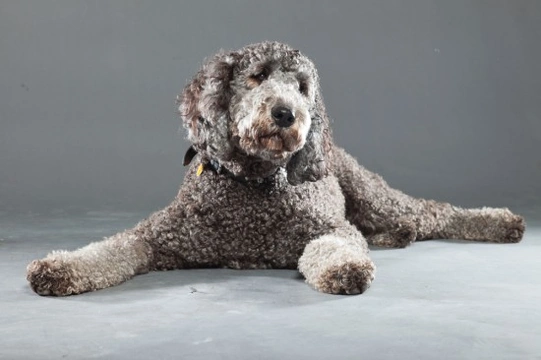
All about the Labradoodle
The rather amusingly named “Labradoodle” is a crossbred dog consisting of the mixture of a Poodle (standard or miniature) and a Labrador Retriever. Despite the fact that the Labradoodle is a crossbreed and not, as some people mistakenly think, a pedigree breed in its own right, the Labradoodle is quickly gaining popularity as a pet within the UK, and good quality Labradoodle dogs and puppies often change hands for prices approaching that of full breed pedigree dogs of these two breeds!
So, why is the Labradoodle so popular, how did it come to be recognised as a type in its own right rather than being considered as a mixed breed or a mongrel, and is a Labradoodle a good choice of dog for you? Read on to find out more!
How did the Labradoodle come into being?
The word “Labradoodle” first came into use to describe a crossed Poodle/Labrador dog during the 1950’s, although the term itself and interest in these dogs didn’t really take off until the 1980’s. Labradoodles were first bred on a serious scale in Australia, where in 1988 a breeder for the Royal Guide Dogs Associations of Australia deliberately crossed a Poodle and a Labrador with the intention of producing a litter with all of the temperament and trainability traits of the Lab, but with the non-shedding, low allergy coat of the Poodle.
Today, Labradoodles are in common use in many countries of the world as assistance dogs, and of course, the same traits that make them a good pick as assistance dogs also makes them eminently suitable and popular as pets.
What makes a Labradoodle?
The Labradoodle is not a pedigree breed of dog, but is instead considered to be a hybrid dog, composed of its two respective breeds. In order for a dog to be reasonably classed as a Labradoodle, their parentage should be a mixture of Labrador and Poodle only, and no other types of dogs. This means that any given Labradoodle could have one Poodle and one Labrador parent respectively, or any combination of a Labrador or Poodle parent bred with an existing Labradoodle, or parents and ancestry that is entirely Labradoodle without any pure bred Poodle or Labrador in it for several generations back.
What are the traits of the Labradoodle?
As there is no breed authority for the Labradoodle (although there are plenty of enthusiast groups and support organisations for owners) there is no recognised breed standard or description of what a Labradoodle should look like. Any hybrid dog type will have significant variations across the range, with some Labradoodle dogs looking more like the Lab than the Poodle and vice versa, and some having certain Poodle or Labrador traits but not others, and of course, a wide range of colours and size variations are possible as well.
Labradoodles as a whole usually share a range of desirable personality traits that are common to both the Poodle and the Labrador, including a high level of intelligence and trainability, a bold, friendly outgoing nature, tolerance of children and often, an affinity for the water.
Why are Labradoodles popular?
Labradoodles enjoy considerable popularity for all of the reasons outlined above, and are handsome, friendly-looking dogs that are generally personable and enjoy the company of people.
One of the largest appealing traits of the Labradoodle for many owners comes thanks to the fact that the coat of the Poodle sheds significantly less than most other breeds of dog, and so Labradoodles that inherit the Poodle coat are often low maintenance and less likely to affect allergy sufferers. The Poodle is often considered to be a hypoallergenic dog, and while there is not really any such thing as a dog that is truly hypoallergenic, nevertheless Poodles and often, Labradoodles with a Poodle-like coat tend to cause a much less severe or common allergy reaction in dog allergy sufferers. Labradoodles with a more Labrador-like coat may not share these traits, or will only possess them to a lesser extent.
Are there any issues or problems with Labradoodles?
Both the Poodle and the Labrador have a genetic predisposition to a variety of health and wellness problems, including hip dysplasia, progressive retinal atrophy and multifocal retinal dysplasia. Due to this, there is an inherent risk that any offspring of Poodle and/or Labrador lines may share the elevated risk factors for these conditions, and the Labradoodle is no different.
As with any planned breeding of dogs, the conformation, health and quality standard of the parent dogs can vary hugely, even in the case of pedigree dogs with papers. It is not uncommon for breeders or dog owners who own a purebred Labrador or Poodle that is not considered to be of a particularly good standard, to choose to crossbreed their dogs with a Poodle or Labrador respectively to produce a Labradoodle, rather than to breed a litter of puppies with undesirable traits for a purebred dog.
Do Labradoodles make good pets?
There is certainly a lot to recommend the Labradoodle as a good choice of dog for people from all walks of life, including families with children. If you are considering buying a Labradoodle for your family, remember that there is a significant amount of variance between the appearance of different Labradoodles, and the quality and ancestry of different breed lines, and be prepared to do your homework and spend plenty of time looking around to find the dog that is the perfect fit for you.
To get an idea of some of the variations between Labradoodles and to find Labradoodles for sale in your area, check out the Labradoodles for sale section here on Pets4Homes.



